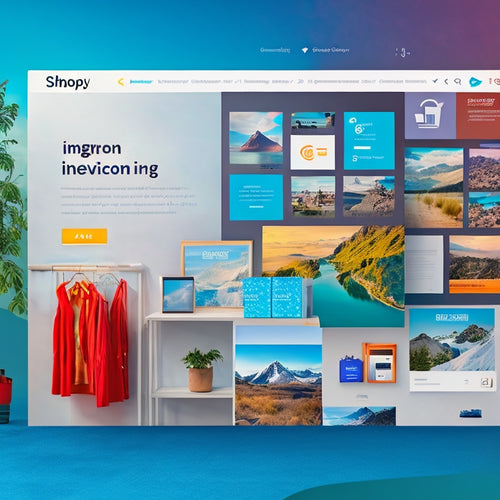
Revolutionize Your Sales Strategy Across Multiple Platforms
Share
You're likely missing out on money if you're not selling across multiple platforms, as 73% of online shoppers use multiple channels to make a purchase. To innovate your sales strategy, start by crafting a multichannel blueprint that defines your target audience, unique selling proposition, and sales channels. Then, maximize each platform's potential by leveraging its strengths and optimizing listings. Finally, streamline sales operations by integrating automation tools and synchronizing data across platforms. By doing so, you'll efficiently manage your multichannel strategy and stay ahead of the competition. Now, discover how to access even more sales opportunities across each platform.
Key Takeaways
• Develop a multichannel sales blueprint to define target audience, unique selling proposition, and sales channels for a seamless customer experience.
• Leverage unique strengths of each platform to tap into vast customer bases and access new revenue streams through targeted marketing and optimization.
• Streamline sales operations by integrating automation tools and synchronizing data across platforms to enhance efficiency, reduce costs, and save time.
• Optimize product listings and content to increase visibility and drive conversions by identifying ideal customer demographics and tailoring content to resonate with the target audience.
• Integrate automation tools to automate repetitive tasks, free up resources, and focus on high-leverage activities like customer engagement and market analysis.
Crafting a Multichannel Blueprint
Develop a multichannel sales blueprint by defining your target audience, identifying your unique selling proposition, and mapping out your sales channels to create a tailored strategy that resonates with your customers.
You'll need to conduct a thorough market analysis to understand your customers' preferences, behaviors, and pain points. By targeting customers effectively, you'll increase conversions and loyalty.
Implementing automation and data synchronization will streamline your operations, reducing errors and workforce costs.
With a well-crafted blueprint, you'll be able to manage multiple sales channels seamlessly, ensuring a consistent customer experience across platforms. This will give you a competitive edge in the market, allowing you to scale your business efficiently and effectively.
Maximizing Platform Potential
By leveraging the unique strengths of each platform, you can tap into their vast customer bases and access new revenue streams, ultimately maximizing your online sales potential. To do this, focus on platform optimization through targeted marketing. Identify your ideal customer demographics, interests, and behaviors, and tailor your content and ads to resonate with them. This will increase visibility, drive conversions, and boost customer retention.
On Instagram, utilize visually-appealing content and influencer partnerships. On eBay and Amazon, optimize product listings and utilize sponsored ads. By customizing your approach to each platform, you'll discover new opportunities and drive business growth.
Streamlining Sales Operations
To efficiently manage your multichannel sales strategy, you need to streamline your sales operations, integrating automation tools and synchronizing data across platforms to minimize errors, reduce costs, and save time.
By doing so, you'll enhance efficiency and free up resources to focus on growth. Sales automation plays an essential role in this process, allowing you to automate repetitive tasks, such as order fulfillment and inventory management. This enables you to allocate more time to high-leverage activities like customer engagement and market analysis.
With streamlined sales operations, you'll be able to respond quickly to changes in the market, capitalize on new opportunities, and ultimately, drive revenue growth.
Frequently Asked Questions
How Do I Handle Customer Complaints Across Multiple Sales Channels?
'You're flooded with 1000+ customer complaints daily across multiple platforms! To tackle this, track Complaint Trends, identify Channel Hopping patterns, and establish a unified response strategy to guarantee consistency and timely resolutions, turning frustration into loyalty.'
Can I Use the Same Product Listing on Different Platforms?
You can maintain brand consistency and visual uniformity by adapting descriptions, images, and formatting to each platform's unique requirements and audience when using the same product listing on different platforms.
What Is the Ideal Ratio of Sales Channels for Optimal Revenue?
You're juggling multiple sales channels, but what's the secret to maximizing revenue? Aim for a 3:2:1 ratio of social media, marketplaces, and niche platforms, using channel hopping to optimize revenue mapping and boost your bottom line.
How Do I Prevent Inventory Discrepancies Between Sales Channels?
To prevent inventory discrepancies, you'll need to implement data reconciliation processes, setting up stock alerts to notify you of discrepancies, and regularly auditing your inventory levels across all sales channels to guarantee accuracy and consistency.
Are There Any Sales Tax Implications When Selling on Multiple Platforms?
When selling on multiple platforms, you'll need to navigate sales tax implications, taking into account tax exemptions and nexus requirements, which vary by state and platform, to guarantee compliance and avoid penalties.
Related Posts
-
The Ultimate Guide to Internal Linking Strategies
Internal linking strategies are essential for improving website structure, search engine optimization (SEO), and use...
-

Enhance Your Shopify Store With Top Integrations in 2023
In 2023, online retailers utilizing Shopify have the opportunity to enhance their e-commerce stores through the inte...
-

Boost Ad Performance and ROI With the Advertiser Success Center
The Advertiser Success Center is a comprehensive platform that offers valuable insights and tools to assist advertis...

